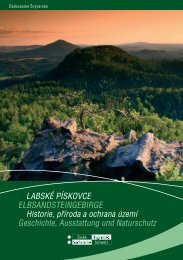ABSTRACT BOOK Sandstone Landscapes ... - Sandstones.org
ABSTRACT BOOK Sandstone Landscapes ... - Sandstones.org
ABSTRACT BOOK Sandstone Landscapes ... - Sandstones.org
Create successful ePaper yourself
Turn your PDF publications into a flip-book with our unique Google optimized e-Paper software.
PZuzana VařilováBohemian Switzerland National Park Administration, Pražská 52, CZ-407 46 Krásná Lípa, CzechRepublic, and Institute of Geology, Academy of Sciences of the Czech Republic (z.varilova@npcs.cz)Ferruginization in sandstones of the Bohemian Switzerland National Park, Czech RepublicA typical feature of sandstones both in the Bohemian Switzerland National Park and elsewhere in theBohemian Cretaceous Basin is Fe-mineralization. Owing to its higher resistance to weathering anddeflation, it acts as a resistant element in the sandstone relief, often creating unique and bizarre forms onthe rock walls, thus increasing the aesthetic value of the landscape. Ferruginization can be foundthroughout almost the whole area of the National Park. It mostly forms subvertical planar tabular bodiesalong contacts of basaltic dykes with the host sandstone and fillings of open joints and faults - Type 1 andirregular, thin undulating parallel crusts, circles or linear concentric tubes in the rock massif - Type 2,whose genesis is explained by the Liesegang phenomena. Type 3, represented by strata-boundsubhorizontal bodies, follows conglomerate beds or strata-parallel fracture zones.The character of ferruginization in sandstones and its relation to basaltic bodies, geological and tectonicconditions was studied by means of field mapping at classical localities. The viewpoint of “Rudolfůvkámen” is a typical and possibly the most frequently visited locality of ferruginous sandstones, where allthree defined types of Fe-mineralization can be found. The following sites are important for the occurrenceof ferruginization: Baldurova jehla, Čínská zeď, pod Pravčickou bránou, Kyjovské údolí (Type 1); Temnýdůl, Nad jeskyní Peklo, Tetřeví kout (Type 2), and the rock formation called “Tři stoly” with asubhorizontal body of Fe-oxyhydroxides (Type 3) that gives rise to mushroom rocks. The measuredorientations (mostly NE–SW to E–W) of encrustations lining joints and of ferruginous tube axes generallycorresponds to the directions given by Seifert (1939). However, ferruginization is more extensive atlocalities on the Czech side of the protected area, than indicated on the Seifert’s map.Spatial relationships between intrusive bodies and individual ferruginization types were confirmed by thestudy of Adamovič (2001). Accumulations of iron oxide and hydroxide (goethite, less often hematite)probably formed during the main volcanic phase in the Late Oligocene and Early Miocene owing totransport of Fe 2+ through the mediation of hot mineralizing post-magmatic fluids. Their main source in theNational Park is probably represented by the Tertiary basaltic rocks: olivine basalt, limburgite, tephrite etc.- Slunečný vrch, Sokolí vrch, Koliště, Kitzenberg, Mlýny, Zámecký vrch, Růžovský vrch, GroβerWinterberg, and also the occurrences of basaltic rocks documented only on the basis of traces after theirquarrying.References:ADAMOVIČ, J. (2001): Ferruginization in sandstones of the Bohemian Cretaceous Basin. Kandidátskádisertační práce, 1-148. Geologický ústav AV ČR; Praha.ADAMOVIČ, J., ULRYCH, J., PEROUTKA, J. (2001): Geology of occurrences of ferruginous sandstonesin North Bohemia: Famous localities revisited. – Geol. Saxonica, Abh. Mus. Miner. Geol. Dresden, 46/47:105-123; Dresden.SEIFERT, A. (1939): Gerichtete Brauneisenanreicherungen im Elbsandsteingebirge (Brauneisenschwartenund -röhren). – Abh. Sächs. geol. Landesamts, 19: 1-38. Freiberg.




